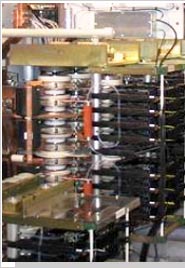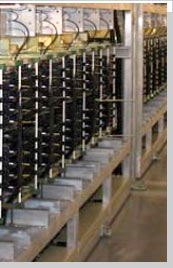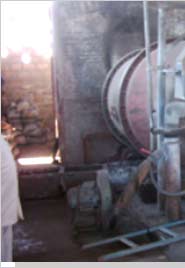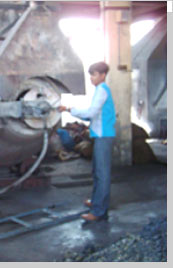Batteries contain a variety of materials that can be reused as a secondary raw material. There are well-established methods and techniques for the recycling of most batteries containing lead, nickel-cadmium, nickel hydride and mercury. For some, such as newer nickel-hydride and lithium systems, recycling methods are still in the early stages.
There are different battery recycling processes, which are aimed at recovering a variety of materials. Important nickel content batteries that are used for recycling include -
Nickel-Cadmium Batteries (NiCd)The nickel cadmium battery was the first rechargeable battery, which was moderately priced and available in the standard cylindrical sizes (AA, AAA, etc.). These batteries come in 2 types - vented cells and hermetically sealed cells. Vented cells must be placed so they can vent decently and also require water for maintenance. They are generally used in commercial and military applications. Hermetically sealed batteries, however, do not need any maintenance and they do not need to be placed in a particular position.
Nickel-cadmium batteries have found usage in low- to moderate-discharge equipment, such as scanners and portable radios. As these batteries contain cadmium, which is a heavy toxic metal, they need special disposal. In the United States, there is a fee built into the price for nickel cadmium batteries that includes proper disposal of the batteries at the end of their useful life. All NiCd batteries are identified as hazardous waste and hence must be recycled. The recycling is used to recover cadmium and iron-nickel for the production of steel.
Nickel-Metal Hydride Batteries (NiMH)The primary difference between NiMH and NiCd batteries is that, in these metal hydride is used instead of the cadmium. The Nickel-metal hydride batteries also come in the standard cylindrical sizes. These batteries also have 2-3 times the capacity of a nickel cadmium, and the memory effect is not as important. Memory effect is when the maximum energy capacity of a battery gradually decreases as a result of being recharged before the battery has totally discharged.
Nickel-metal hydride batteries are generally used in high-discharge equipment, such as portable power tools, digital cameras and laptops. They are conceived as non-hazardous waste, but do contain elements, which can be recycled. The individual materials of the batteries are mechanically separated, and a high nickel content is generated and used in the production of stainless steel.
Recycling ProcessEach battery has a unique chemical makeup, and hence, there are different ways of recycling and proper disposal of them. In different countries, there are retailers who will recycle most types of batteries; and if the battery is not recyclable, they will get rid of it in a safe manner. Nickel is recovered from nickel content batteries in following ways -


Nickel is recovered from NiCd batteries by either separating the different materials, which make up the battery (nickel, plastic, acid, etc.) prior to metallurgical process. Alternatively, the batteries can be recycled as a whole through heat treatment in a special type of furnace with metals recovered at the end of this method.
NiMH BatteryNickel is recovered from NiMH batteries by mechanically separating the individual materials (plastic, hydrogen and nickel) within a vacuum chamber to prevent the hydrogen escape. The yield of this process is a product with high nickel content that can be used in the production of stainless steel.
Infrastructure In 1994, the Rechargeable Battery Recycling Corporation (RBRC) was founded to encourage the recycling of rechargeable batteries in North America. RBRC is a non-profit organization, which collects batteries from consumers and businesses and sends them to recycling companies. Inmetco and Toxco are one of the best known recycling companies in North America. Europe and Asia have had programs and facilities to recycle spent batteries for several years. Sony and Sumitomo Metal in Japan have formulated a technology to recycle cobalt and other precious metals from spent lithium ion batteries.


Battery recycling plants necessitate that the batteries be sorted on the basis of their chemistries. Some sorting should be done prior to the battery coming at the recycling plants. Nickel-cadmium, nickel-metal-hydride are placed in assigned boxes at the collection point. According to battery recyclers, if a steady stream of batteries, sorted by chemistry, were available at no cost, recycling would be a profitable business. However preparation and transportation add to the cost.
The recycling process begins by removing the combustible material, like plastics and insulation, with a gas fired thermal oxidizer. Gases from the thermal oxidizer are directed to the plant's scrubber where they are neutralized to remove pollutants. The methods leaves the clean, naked cells that contain valuable metal content.
The cells are then chopped into small pieces that are heated until the metal liquefies. Non-metallic substances are burned off; that leaves a black slag on top, which is removed with a slag arm. The different alloys settle as per their weights and are skimmed off like cream from raw milk.
Cadmium is comparatively light and vaporizes at high temperatures. In a process, which appears like a pan boiling over, a fan blows the cadmium vapour into a large tube that is cooled with water mist. This makes the vapour to condense and produces cadmium, which is 99.95 % pure.
Some recyclers do not separate the metals on site but pour the liquid metals directly into what is referred to as 'pigs' (65 pounds) or 'hogs' (2000 pounds). The pigs and hogs are then send to metal recovery facilities. Here, the material is used to generate nickel, chromium and iron re-melt alloy for the production of stainless steel and other high-end products.
Present battery recycling processes require a high amount of energy. It takes 6-10 times the amount of energy to reclaim metals from recycled batteries than it would through other methods.
Different countries impose their own rules and regulations in making recycling feasible. In North America, some recyclers bill on weight. Their rates vary according to chemistry. Systems, which yield high metal retrieval rates are priced lower than those that yield less valuable metals.
Nickel-metal-hydride produce the best return. It generates sufficient nickel to pay for the process. The highest recycling fees apply to nickel-cadmium and lithium ion batteries is due to the fact that demand for cadmium is low and lithium-ion contains little retrievable metal.
Some countries fix the cost of recycling on the basis of tonnage alone. The flat cost for recycling of batteries is about $1,000 to $2,000US per ton. Europe hopes to attain a cost per ton of $300US. Ideally, this would include transportation, however, moving the goods is anticipated to double the overall cost. Due to this reason, Europe has set up various smaller processing locations in strategic geographic locations.
Types / GradesDifferent grades of nickel content battery scrap is used for recycling purposes to recover pure nickel. Some of the important grades include -
|
Disadvantages of Improper Disposal of Batteries
Improper disposal of batteries can result in the following potential problems or hazards -
- Contribute to heavy metals, which potentially may leach from solid waste landfills.
- Pollute the lakes and streams as the metals vaporize into the air when burned.
- Expose the environment and water to toxic materials.
- Contain strong corrosive acids.
- Cause burns or danger to eyes and skin.
Modern batteries are often promoted on the basis of their environmental qualities. Nickel-Cadmium batteries an environmental problem on careless disposal, this chemistry continues to hold a crucial position among rechargeable batteries. Power tools are virtually powered by nickel-cadmium. Lithium-ion would simply be too fragile to replace many of these older, but environmentally hostile, battery chemistries.
Careless disposal of nickel-cadmium has found to be hazardous to the environment. If used in landfills, the cadmium will finally dissolve itself and the toxic substance can seep into the water supply, resulting in serious health problems.
Though nickel-metal-hydride is believed to be environment friendly, their chemistry is also being recycled. The primary derivative is nickel that is considered semi-toxic. Nickel-metal-hydride also contains electrolyte, which in large amounts, is hazardous. If no disposal service is available in a region, individual nickel-metal-hydride batteries can be discarded with other household wastes. If 10 or more batteries are accumulated, the user should look at disposing of these packs in a secure waste landfill.
